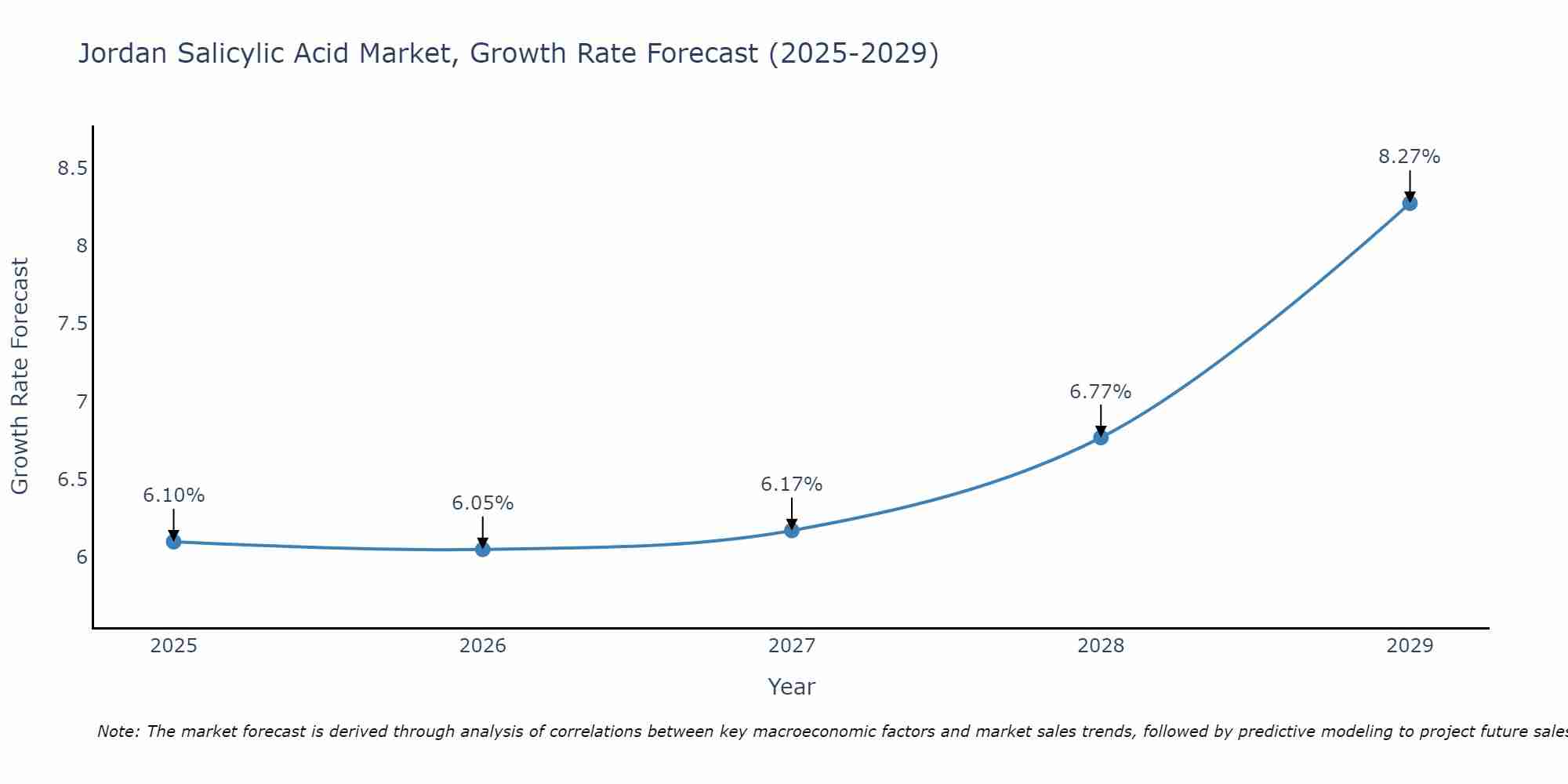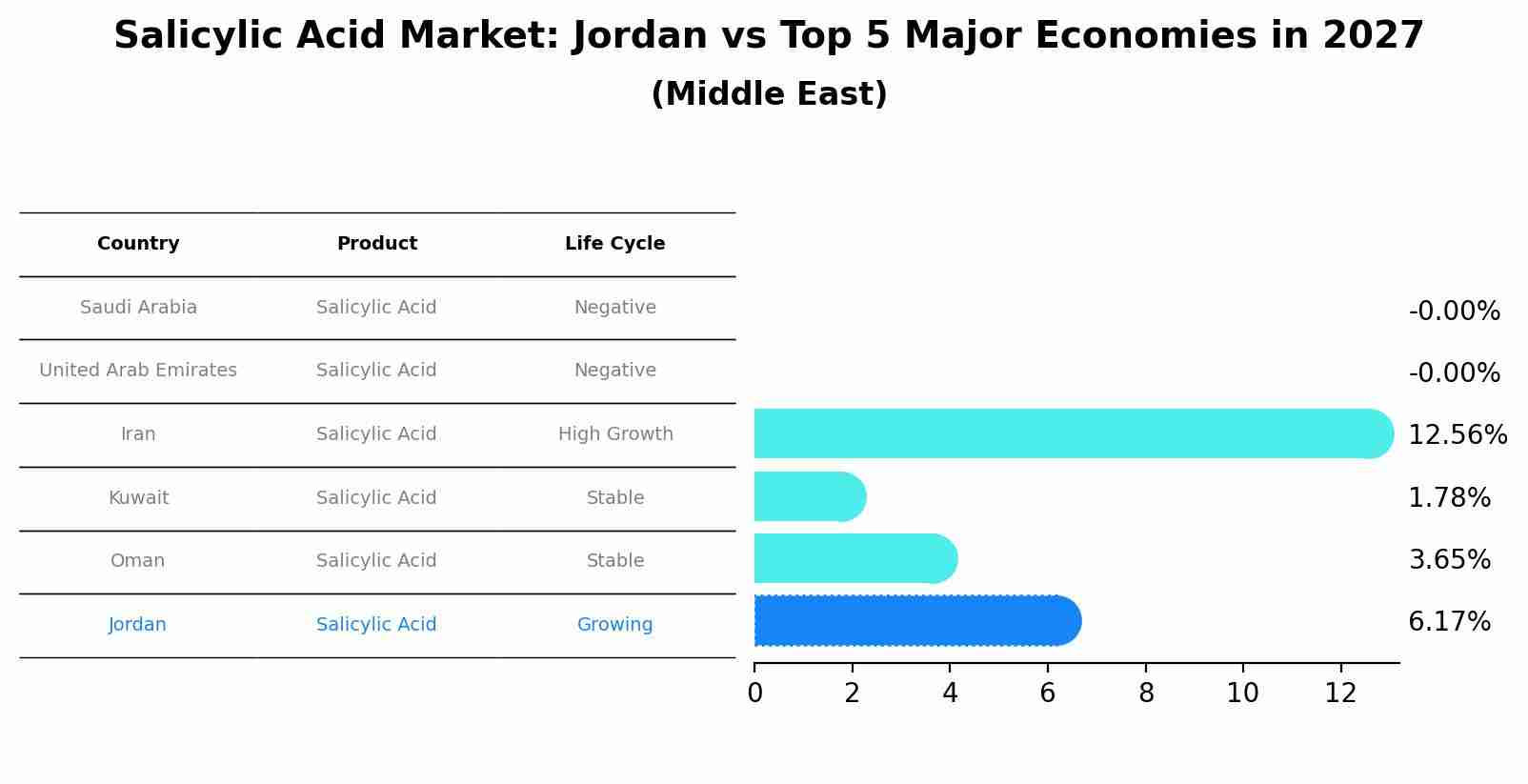Jordan Salicylic Acid Market (2025-2031) Outlook | Companies, Trends, Analysis, Forecast, Share, Revenue, Growth, Size, Industry, Value
| Product Code: ETC102365 | Publication Date: Jun 2021 | Updated Date: Jun 2025 | Product Type: Report | |
| Publisher: 6Wresearch | Author: Shubham Padhi | No. of Pages: 70 | No. of Figures: 35 | No. of Tables: 5 |
Jordan Salicylic Acid Market Size Growth Rate
The Jordan Salicylic Acid Market is projected to witness mixed growth rate patterns during 2025 to 2029. Commencing at 6.10% in 2025, growth builds up to 8.27% by 2029.

Salicylic Acid Market: Jordan vs Top 5 Major Economies in 2027 (Middle East)
In the Middle East region, the Salicylic Acid market in Jordan is projected to expand at a growing growth rate of 6.17% by 2027. The largest economy is Saudi Arabia, followed by United Arab Emirates, Iran, Kuwait and Oman.

Jordan Salicylic Acid Market Overview
The Jordanian Salicylic Acid market is witnessing steady growth due to increasing demand from the pharmaceutical, cosmetics, and personal care industries. Salicylic Acid is primarily used in skincare products for its exfoliating and anti-inflammatory properties, making it a popular ingredient in acne treatments and anti-aging products. The market is driven by the rising consumer awareness about skincare and the growing focus on personal grooming. Additionally, the pharmaceutical sector`s demand for salicylic acid in the production of medications for various skin conditions further contributes to market growth. Local manufacturers and international suppliers play a significant role in meeting the market demand, ensuring a competitive landscape and a diverse range of products for consumers in Jordan.
Jordan Salicylic Acid Market Trends
The Jordan Salicylic Acid market is experiencing a growing demand due to the rising awareness among consumers about skincare benefits. Salicylic acid is known for its effectiveness in treating acne and various skin conditions, driving its popularity in the cosmetics and personal care industry. Moreover, the increasing prevalence of skin issues such as acne and psoriasis is further fueling the market growth. Key trends in the Jordan Salicylic Acid market include the introduction of innovative products with higher concentrations of salicylic acid, the adoption of natural and organic formulations, and the expansion of distribution channels through online platforms. Companies are focusing on product development and marketing strategies to capitalize on the growing demand for salicylic acid-based skincare solutions in Jordan.
Jordan Salicylic Acid Market Challenges
In the Jordan Salicylic Acid market, challenges are primarily related to regulatory restrictions, market competition, and pricing pressures. Regulatory restrictions can impact the import and use of salicylic acid in various industries, leading to limitations in market growth. Additionally, the presence of established international and local competitors in the market creates challenges for new entrants and smaller players to gain market share. Pricing pressures from fluctuating raw material costs and competitive pricing strategies further add complexity to the market landscape. Companies operating in the Jordan Salicylic Acid market need to navigate these challenges by ensuring compliance with regulations, differentiating their products or services, and implementing effective pricing strategies to remain competitive and sustain growth in the market.
Jordan Salicylic Acid Market Investment Opportunities
The Jordan Salicylic Acid Market offers promising investment opportunities due to the increasing demand for skincare and personal care products containing salicylic acid. Salicylic acid is known for its effectiveness in treating various skin conditions such as acne, psoriasis, and warts, driving its popularity in the cosmetics industry. With the rising awareness of skincare and beauty products among consumers in Jordan, there is a growing market for salicylic acid-based products. Investors can consider opportunities in manufacturing and supplying salicylic acid to cosmetic companies, investing in research and development for innovative applications of salicylic acid, or even launching their own skincare brands featuring this ingredient. Additionally, partnerships with local cosmetic companies or retailers can provide avenues for market penetration and growth in the Jordanian market.
Jordan Salicylic Acid Market Government Policy
The Jordanian government has implemented policies to regulate the sale and distribution of salicylic acid in the market. This includes ensuring that products containing salicylic acid adhere to safety and quality standards set by the Jordan Food and Drug Administration (JFDA). Importers and manufacturers are required to obtain approval from the JFDA before introducing salicylic acid products into the market. Additionally, there are restrictions on the concentration of salicylic acid allowed in cosmetic and pharmaceutical products to protect consumer health and safety. The government also monitors pricing and advertising practices to prevent unfair competition and ensure transparency in the Jordan salicylic acid market. Overall, these policies aim to promote a competitive and well-regulated market for salicylic acid products in Jordan.
Jordan Salicylic Acid Market Future Outlook
The Jordan Salicylic Acid Market is expected to witness steady growth in the coming years due to increasing demand from the cosmetics and personal care industries. The rising awareness about skincare and the benefits of salicylic acid for treating acne and other skin issues are driving market growth. Additionally, the growing trend of natural and organic skincare products is likely to further boost the demand for salicylic acid in Jordan. However, factors such as regulatory constraints and competition from alternative ingredients may pose challenges to market expansion. Overall, with the increasing focus on personal grooming and skincare routines, the Jordan Salicylic Acid Market is forecasted to experience a positive outlook in the future.
Key Highlights of the Report:
- Jordan Salicylic Acid Market Outlook
- Market Size of Jordan Salicylic Acid Market, 2021
- Forecast of Jordan Salicylic Acid Market, 2031
- Historical Data and Forecast of Jordan Salicylic Acid Revenues & Volume for the Period 2021 - 2031
- Jordan Salicylic Acid Market Trend Evolution
- Jordan Salicylic Acid Market Drivers and Challenges
- Jordan Salicylic Acid Price Trends
- Jordan Salicylic Acid Porter's Five Forces
- Jordan Salicylic Acid Industry Life Cycle
- Historical Data and Forecast of Jordan Salicylic Acid Market Revenues & Volume By Application for the Period 2021 - 2031
- Historical Data and Forecast of Jordan Salicylic Acid Market Revenues & Volume By Pharmaceutical for the Period 2021 - 2031
- Historical Data and Forecast of Jordan Salicylic Acid Market Revenues & Volume By Food & Preservatives for the Period 2021 - 2031
- Historical Data and Forecast of Jordan Salicylic Acid Market Revenues & Volume By Cosmetics for the Period 2021 - 2031
- Historical Data and Forecast of Jordan Salicylic Acid Market Revenues & Volume By Others for the Period 2021 - 2031
- Jordan Salicylic Acid Import Export Trade Statistics
- Market Opportunity Assessment By Application
- Jordan Salicylic Acid Top Companies Market Share
- Jordan Salicylic Acid Competitive Benchmarking By Technical and Operational Parameters
- Jordan Salicylic Acid Company Profiles
- Jordan Salicylic Acid Key Strategic Recommendations
Frequently Asked Questions About the Market Study (FAQs):
1 Executive Summary |
2 Introduction |
2.1 Key Highlights of the Report |
2.2 Report Description |
2.3 Market Scope & Segmentation |
2.4 Research Methodology |
2.5 Assumptions |
3 Jordan Salicylic Acid Market Overview |
3.1 Jordan Country Macro Economic Indicators |
3.2 Jordan Salicylic Acid Market Revenues & Volume, 2021 & 2031F |
3.3 Jordan Salicylic Acid Market - Industry Life Cycle |
3.4 Jordan Salicylic Acid Market - Porter's Five Forces |
3.5 Jordan Salicylic Acid Market Revenues & Volume Share, By Form, 2021 & 2031F |
4 Jordan Salicylic Acid Market Dynamics |
4.1 Impact Analysis |
4.2 Market Drivers |
4.3 Market Restraints |
5 Jordan Salicylic Acid Market Trends |
6 Jordan Salicylic Acid Market, By Types |
6.1 Jordan Salicylic Acid Market, By Application |
6.1.1 Overview and Analysis |
6.1.2 Jordan Salicylic Acid Market Revenues & Volume, By Application, 2018 - 2027F |
6.1.3 Jordan Salicylic Acid Market Revenues & Volume, By Pharmaceutical, 2018 - 2027F |
6.1.4 Jordan Salicylic Acid Market Revenues & Volume, By Food & Preservatives, 2018 - 2027F |
6.1.5 Jordan Salicylic Acid Market Revenues & Volume, By Cosmetics, 2018 - 2027F |
6.1.6 Jordan Salicylic Acid Market Revenues & Volume, By Others, 2018 - 2027F |
7 Jordan Salicylic Acid Market Import-Export Trade Statistics |
7.1 Jordan Salicylic Acid Market Export to Major Countries |
7.2 Jordan Salicylic Acid Market Imports from Major Countries |
8 Jordan Salicylic Acid Market Key Performance Indicators |
9 Jordan Salicylic Acid Market - Opportunity Assessment |
9.1 Jordan Salicylic Acid Market Opportunity Assessment, By Application, 2021 & 2031F |
10 Jordan Salicylic Acid Market - Competitive Landscape |
10.1 Jordan Salicylic Acid Market Revenue Share, By Companies, 2021 |
10.2 Jordan Salicylic Acid Market Competitive Benchmarking, By Operating and Technical Parameters |
11 Company Profiles |
12 Recommendations |
13 Disclaimer |
- Single User License$ 1,995
- Department License$ 2,400
- Site License$ 3,120
- Global License$ 3,795
Search
Thought Leadership and Analyst Meet
Our Clients
Related Reports
- Afghanistan Apparel Market (2026-2032) | Growth, Outlook, Industry, Segmentation, Forecast, Size, Companies, Trends, Value, Share, Analysis & Revenue
- Canada Oil and Gas Market (2026-2032) | Share, Segmentation, Value, Industry, Trends, Forecast, Analysis, Size & Revenue, Growth, Competitive Landscape, Outlook, Companies
- Germany Breakfast Food Market (2026-2032) | Industry, Share, Growth, Size, Companies, Value, Analysis, Revenue, Trends, Forecast & Outlook
- Australia Briquette Market (2025-2031) | Growth, Size, Revenue, Forecast, Analysis, Trends, Value, Share, Industry & Companies
- Vietnam System Integrator Market (2025-2031) | Size, Companies, Analysis, Industry, Value, Forecast, Growth, Trends, Revenue & Share
- ASEAN and Thailand Brain Health Supplements Market (2025-2031) | Strategy, Consumer Insights, Analysis, Investment Trends, Opportunities, Growth, Size, Share, Industry, Revenue, Segments, Value, Segmentation, Supply, Forecast, Restraints, Outlook, Competition, Drivers, Trends, Demand, Pricing Analysis, Competitive, Strategic Insights, Companies, Challenges
- ASEAN Bearings Market (2025-2031) | Strategy, Consumer Insights, Analysis, Investment Trends, Opportunities, Growth, Size, Share, Industry, Revenue, Segments, Value, Segmentation, Supply, Forecast, Restraints, Outlook, Competition, Drivers, Trends, Demand, Pricing Analysis, Competitive, Strategic Insights, Companies, Challenges
- Europe Flooring Market (2025-2031) | Outlook, Share, Industry, Trends, Forecast, Companies, Revenue, Size, Analysis, Growth & Value
- Saudi Arabia Manlift Market (2025-2031) | Outlook, Size, Growth, Trends, Companies, Industry, Revenue, Value, Share, Forecast & Analysis
- Uganda Excavator, Crane, and Wheel Loaders Market (2025-2031) | Strategy, Consumer Insights, Analysis, Investment Trends, Opportunities, Growth, Size, Share, Industry, Revenue, Segments, Value, Segmentation, Supply, Forecast, Restraints, Outlook, Competition, Drivers, Trends, Demand, Pricing Analysis, Competitive, Strategic Insights, Companies, Challenges
Industry Events and Analyst Meet
Whitepaper
- Middle East & Africa Commercial Security Market Click here to view more.
- Middle East & Africa Fire Safety Systems & Equipment Market Click here to view more.
- GCC Drone Market Click here to view more.
- Middle East Lighting Fixture Market Click here to view more.
- GCC Physical & Perimeter Security Market Click here to view more.
6WResearch In News
- Doha a strategic location for EV manufacturing hub: IPA Qatar
- Demand for luxury TVs surging in the GCC, says Samsung
- Empowering Growth: The Thriving Journey of Bangladesh’s Cable Industry
- Demand for luxury TVs surging in the GCC, says Samsung
- Video call with a traditional healer? Once unthinkable, it’s now common in South Africa
- Intelligent Buildings To Smooth GCC’s Path To Net Zero


















